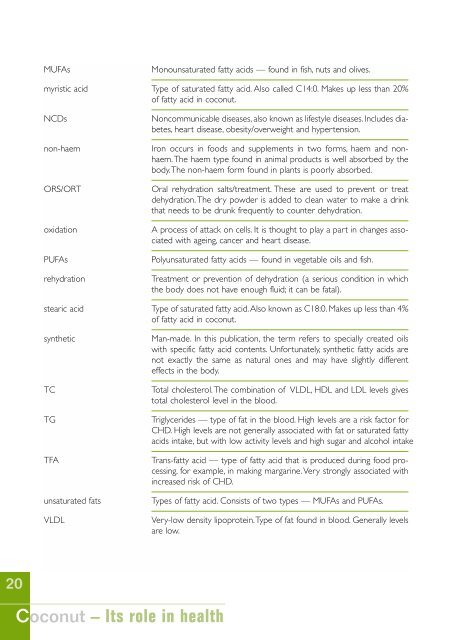Coconut - Secretariat of the Pacific Community
Coconut - Secretariat of the Pacific Community
Coconut - Secretariat of the Pacific Community
Create successful ePaper yourself
Turn your PDF publications into a flip-book with our unique Google optimized e-Paper software.
20<br />
MUFAs Monounsaturated fatty acids — found in fish, nuts and olives.<br />
myristic acid Type <strong>of</strong> saturated fatty acid. Also called C14:0. Makes up less than 20%<br />
<strong>of</strong> fatty acid in coconut.<br />
NCDs Noncommunicable diseases, also known as lifestyle diseases. Includes diabetes,<br />
heart disease, obesity/overweight and hypertension.<br />
non-haem Iron occurs in foods and supplements in two forms, haem and nonhaem.The<br />
haem type found in animal products is well absorbed by <strong>the</strong><br />
body.The non-haem form found in plants is poorly absorbed.<br />
ORS/ORT Oral rehydration salts/treatment. These are used to prevent or treat<br />
dehydration. The dry powder is added to clean water to make a drink<br />
that needs to be drunk frequently to counter dehydration.<br />
oxidation A process <strong>of</strong> attack on cells. It is thought to play a part in changes associated<br />
with ageing, cancer and heart disease.<br />
PUFAs Polyunsaturated fatty acids — found in vegetable oils and fish.<br />
rehydration Treatment or prevention <strong>of</strong> dehydration (a serious condition in which<br />
<strong>the</strong> body does not have enough fluid; it can be fatal).<br />
stearic acid Type <strong>of</strong> saturated fatty acid.Also known as C18:0. Makes up less than 4%<br />
<strong>of</strong> fatty acid in coconut.<br />
syn<strong>the</strong>tic Man-made. In this publication, <strong>the</strong> term refers to specially created oils<br />
with specific fatty acid contents. Unfortunately, syn<strong>the</strong>tic fatty acids are<br />
not exactly <strong>the</strong> same as natural ones and may have slightly different<br />
effects in <strong>the</strong> body.<br />
TC Total cholesterol.The combination <strong>of</strong> VLDL, HDL and LDL levels gives<br />
total cholesterol level in <strong>the</strong> blood.<br />
TG Triglycerides — type <strong>of</strong> fat in <strong>the</strong> blood. High levels are a risk factor for<br />
CHD. High levels are not generally associated with fat or saturated fatty<br />
acids intake, but with low activity levels and high sugar and alcohol intake<br />
TFA Trans-fatty acid — type <strong>of</strong> fatty acid that is produced during food processing,<br />
for example, in making margarine.Very strongly associated with<br />
increased risk <strong>of</strong> CHD.<br />
unsaturated fats Types <strong>of</strong> fatty acid. Consists <strong>of</strong> two types — MUFAs and PUFAs.<br />
VLDL Very-low density lipoprotein.Type <strong>of</strong> fat found in blood. Generally levels<br />
are low.<br />
<strong>Coconut</strong> – Its role in health
















